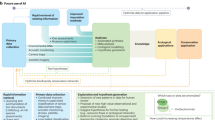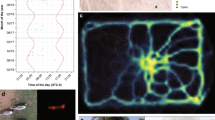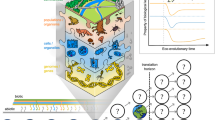Abstract
The emergence of generative artificial intelligence (AI) models specializing in the generation of new data with the statistical patterns and properties of the data upon which the models were trained has profoundly influenced a range of academic disciplines, industry and public discourse. Combined with the vast amounts of diverse data now available to ecologists, from genetic sequences to remotely sensed animal tracks, generative AI presents enormous potential applications within ecology. Here we draw upon a range of fields to discuss unique potential applications in which generative AI could accelerate the field of ecology, including augmenting data-scarce datasets, extending observations of ecological patterns and increasing the accessibility of ecological data. We also highlight key challenges, risks and considerations when using generative AI within ecology, such as privacy risks, model biases and environmental effects. Ultimately, the future of generative AI in ecology lies in the development of robust interdisciplinary collaborations between ecologists and computer scientists. Such partnerships will be important for embedding ecological knowledge within AI, leading to more ecologically meaningful and relevant models. This will be critical for leveraging the power of generative AI to drive ecological insights into species across the globe.
This is a preview of subscription content, access via your institution
Access options
Access Nature and 54 other Nature Portfolio journals
Get Nature+, our best-value online-access subscription
$32.99 / 30 days
cancel any time
Subscribe to this journal
Receive 12 digital issues and online access to articles
$119.00 per year
only $9.92 per issue
Buy this article
- Purchase on SpringerLink
- Instant access to full article PDF
Prices may be subject to local taxes which are calculated during checkout
Similar content being viewed by others
References
Christin, S., Hervet, É. & Lecomte, N. Applications for deep learning in ecology. Methods Ecol. Evol. 10, 1632–1644 (2019).
Tuia, D. et al. Perspectives in machine learning for wildlife conservation. Nat. Commun. 13, 792 (2022).
Norouzzadeh, M. S. et al. Automatically identifying, counting, and describing wild animals in camera-trap images with deep learning. Proc. Natl Acad. Sci. USA 115, E5716–E5725 (2018).
Pichler, M., Boreux, V., Klein, A.-M., Schleuning, M. & Hartig, F. Machine learning algorithms to infer trait-matching and predict species interactions in ecological networks. Methods Ecol. Evol. 11, 281–293 (2020).
Jumper, J. et al. Highly accurate protein structure prediction with AlphaFold. Nature 596, 583–589 (2021).
Walraven, E., Spaan, M. T. J. & Bakker, B. Traffic flow optimization: a reinforcement learning approach. Eng. Appl. Artif. Intell. 52, 203–212 (2016).
Shahriar, S. et al. Putting GPT-4o to the sword: a comprehensive evaluation of language, vision, speech, and multimodal proficiency. Appl. Sci. 14, 7782 (2024).
Tian, Y. et al. StableRep: synthetic images from text-to-image models make strong visual representation learners. In Proc. 37th International Conference on Neural Information Processing Systems 48382–48402 (Curran Associates, 2024).
Esser, P. et al. Structure and content-guided video synthesis with diffusion models in 2023 IEEE/CVF International Conference on Computer Vision (ICCV) 7312–7322 (IEEE, 2023).
Naveed, H. et al. A comprehensive overview of large language models. Preprint at arXiv https://doi.org/10.48550/arXiv.2307.06435 (2024).
Lam, R. et al. Learning skillful medium-range global weather forecasting. Science 382, 1416–1421 (2023).
Lin, Z. et al. Evolutionary-scale prediction of atomic-level protein structure with a language model. Science 379, 1123–1130 (2023).
Nathan, R. et al. Big-data approaches lead to an increased understanding of the ecology of animal movement. Science 375, eabg1780 (2022).
Sugai, L. S. M., Silva, T. S. F., Ribeiro, J. W. Jr & Llusia, D. Terrestrial passive acoustic monitoring: review and perspectives. BioScience 69, 15–25 (2019).
Beery, S. in AI for Social Impact (eds Tambe, M. et al.) https://www.ai4sibook.org/wp-content/uploads/2022/08/MegaDetector.pdf (2022).
Hart, A. G. et al. Assessing the accuracy of free automated plant identification applications. People Nat. 5, 929–937 (2023).
Beery, S., Van Horn, G. & Perona, P. Recognition in terra incognita. In Proc. European Conference on Computer Vision (eds. Ferrari, V. et al.) 456–473 (2018).
Koh, P. W. et al. WILDS: a benchmark of in-the-wild distribution shifts. In Proc. 38th International Conference on Machine Learning, 139 (ICML, 2021).
van Dyk, D. A. & Meng, X.-L. The art of data augmentation. J. Comput. Graph. Stat. 10, 1–50 (2001).
Hittmeir, M., Ekelhart, A. & Mayer, R. On the utility of synthetic data: an empirical evaluation on machine learning tasks. In ARES '19: Proceedings of the 14th International Conference on Availability, Reliability and Security, article no. 29 (2019).
Goodfellow, I. et al. Generative adversarial nets. In Proceedings of the 27th International Conference on Neural Information Processing Systems 2672–2680 (Curran Associates, 2014).
Dhariwal, P. & Nichol, A. Diffusion models beat GANs on image synthesis. In Proc. 35th International Conference on Neural Information Processing Systems, https://doi.org/10.5555/3540261.3540933 (Curran Associates, 2021).
Azizi, S. et al. Synthetic data from diffusion models improves ImageNet classification. Trans. Mach. Learn. Res. (2023).
Beery, S. et al. Synthetic examples improve generalization for rare classes. In 2020 IEEE Winter Conference on Applications of Computer Vision (WACV) 852–862 (IEEE, 2020).
Vendrow, J., Jain, S., Engstrom, L. & Madry, A. Dataset interfaces: diagnosing model failures using controllable counterfactual generation. In Data-Centric Machine Learning Research (DMLR) Workshop at ICML 2023, https://dmlr.ai/assets/accepted-papers/49/CameraReady/icml.pdf (2023).
Ghiasi, G. et al. Simple copy-paste is a strong data augmentation method for instance segmentation. In IEEE/CVF Conference on Computer Vision and Pattern Recognition (CVPR), https://doi.org/10.1109/CVPR46437.2021.00294 (IEEE, 2021).
Lu, C.-Y., Arcega Rustia, D. J. & Lin, T.-T. Generative adversarial network based image augmentation for insect pest classification enhancement. IFAC Pap. 52, 1–5 (2019).
Schwartz, I. et al. Discriminative class tokens for text-to-image diffusion models. In 2023 IEEE/CVF International Conference on Computer Vision (ICCV) 22668–22678 (IEEE, 2023).
Werber, Y., Sextin, H., Yovel, Y. & Sapir, N. BATScan: a radar classification tool reveals large-scale bat migration patterns. Meth. Ecol. Evol. 14, 1764–1779 (2023).
Wan, Z. & Dodge, S. A generative trajectory interpolation method for imputing gaps in wildlife movement data. In GeoWildLife 23 Proc. 1st ACM SIGSPATIAL International Workshop AI-Driven Spatio-Temporal Data Analysis Wildlife Conservation 1–8 (ACM, 2023).
Luleci, F., Catbas, F. N. & Avci, O. Generative adversarial networks for labeled acceleration data augmentation for structural damage detection. J. Civ. Struct. Health Monit. 13, 181–198 (2023).
Jiguet, F. et al. Multi-sensor data loggers identify the location and timing in four poaching cases of the endangered Eurasian Curlew Numenius arquata. Forensic Sci. Int. Anim. Environ. 4, 100069 (2023).
Gal, R. et al. An image is worth one word: personalizing text-to-image generation using textual inversion. In Proc. 11th International Conference on Learning Representations, https://openreview.net/forum?id=NAQvF08TcyG (2023).
Yuan, J. et al. Real-fake: effective training data synthesis through distribution matching. In Proc. 12th International Conference on Learning Representations, https://openreview.net/pdf?id=svIdLLZpsA (2023).
Hirn, J. et al. A deep generative artificial intelligence system to predict species coexistence patterns. Meth. Ecol. Evol. 13, 1052–1061 (2022).
Borowiec, M. L. et al. Deep learning as a tool for ecology and evolution. Meth. Ecol. Evol. 13, 1640–1660 (2022).
Chesson, P. General theory of competitive coexistence in spatially-varying environments. Theor. Popul. Biol. 58, 211–237 (2000).
Roy, A., Fablet, R. & Bertrand, S. L. Using generative adversarial networks (GAN) to simulate central-place foraging trajectories. Meth. Ecol. Evol. 13, 1275–1287 (2022).
Peck, S. L. Simulation as experiment: a philosophical reassessment for biological modeling. Trends Ecol. Evol. 19, 530–534 (2004).
Hirn, J., Sanz, V. & Verdú, M. in Generative AI to Understand Complex Ecological Interactions 293–308 (Springer, 2024).
DeAngelis, D. L. & Diaz, S. G. Decision-making in agent-based modeling: a current review and future prospectus. Front. Ecol. Evol. 6, 237 (2019).
Ghaffarzadegan, N., Majumdar, A., Williams, R. & Hosseinichimeh, N. Generative agent-based modeling: an introduction and tutorial. Syst. Dyn. Rev. 40, e1761 (2024).
Williams, R., Hosseinichimeh, N., Majumdar, A. & Ghaffarzadegan, N. Epidemic modeling with generative agents. Preprint at arXiv https://doi.org/10.48550/arXiv.2307.04986 (2023).
Park, J. S. et al. Generative agents: interactive simulacra of human behavior. In Proc. 36th Annual ACM Symposium on User Interface Software and Technology 1–22 (Association for Computing Machinery, 2023).
Potts, J. R. & Lewis, M. A. How memory of direct animal interactions can lead to territorial pattern formation. J. R. Soc. Interface 13, 20160059 (2016).
Strandburg-Peshkin, A., Farine, D. R., Crofoot, M. C. & Couzin, I. D. Habitat and social factors shape individual decisions and emergent group structure during baboon collective movement. eLife 6, e19505 (2017).
Han, B. A. et al. A synergistic future for AI and ecology. Proc. Natl Acad. Sci. USA 120, e2220283120 (2023).
Abrahms, B. et al. Climate change as a global amplifier of human–wildlife conflict. Nat. Clim. Change 13, 224–234 (2023).
Hennessy, A., Clarke, K. & Lewis, M. Generative adversarial network synthesis of hyperspectral vegetation data. Remote Sens. 13, 2243 (2021).
Requena-Mesa, C. et al. in Pattern Recognition (eds Fink, G. A. et al.) 203–217 (Springer, 2019).
Dinnage, R. How many variables does Wordclim have, really? Generative A.I. unravels the intrinsic dimension of bioclimatic variables. Preprint at bioRxiv https://doi.org/10.1101/2023.06.12.544623 (2023).
Castro, A., Pinto, J., Reino, L., Pipek, P. & Capinha, C. Large language models overcome the challenges of unstructured text data in ecology. Ecol. Inform. 82, 102742 (2024).
Gao, Y. et al. Retrieval-augmented generation for large language models: a survey. Preprint at arXiv https://doi.org/10.48550/arXiv.2312.10997 (2024).
Cooper, N. et al. Harnessing large language models for coding, teaching and inclusion to empower research in ecology and evolution. Methods Ecol. Evol. 15, 1757–1763 (2024).
Suri, S. Defining our future with generative AI. Nat. Comput. Sci. 4, 641–643 (2024).
Ferrara, E. Should ChatGPT be biased? Challenges and risks of bias in large language models. First Monday 28, 11 (2023).
Schramowski, P., Turan, C., Andersen, N., Rothkopf, C. A. & Kersting, K. Large pre-trained language models contain human-like biases of what is right and wrong to do. Nat. Mach. Intell. 4, 258–268 (2022).
Konno, K. et al. Ignoring non-English-language studies may bias ecological meta-analyses. Ecol. Evol. 10, 6373–6384 (2020).
Maas, B. et al. Women and global south strikingly underrepresented among top-publishing ecologists. Conserv. Lett. 14, e12797 (2021).
Clark, J. A. & May, R. M. Taxonomic bias in conservation research. Science 297, 191–192 (2002).
Hughes, A. C. et al. Who is publishing in ecology and evolution? The underrepresentation of women and the Global South. Front. Environ. Sci. 11, 1211211 (2023).
Azamfirei, R., Kudchadkar, S. R. & Fackler, J. Large language models and the perils of their hallucinations. Crit. Care 27, 120 (2023).
Boyko, J. et al. An interdisciplinary outlook on large language models for scientific research. Preprint at arXiv https://doi.org/10.48550/arXiv.2311.04929 (2023).
Gupta, U. et al. Chasing carbon: the elusive environmental footprint of computing. In 2021 IEEE International Symposium on High-Performance Computer Architecture (HPCA) 854–867 (IEEE, 2021).
Chien, A. A. et al. Reducing the carbon impact of generative AI inference (today and in 2035). In Proc. 2nd Workshop on Sustainable Computer Systems 1–7 (ACM, 2023).
Crawford, K. Generative AI’s environmental costs are soaring — and mostly secret. Nature 626, 693 (2024). –693.
Elkin-Koren, N., Hacohen, U., Livni, R. & Moran, S. Can copyright be reduced to privacy? In 5th Symposium on Foundations of Responsible Computing (FORC 2024) 3:1–3:18 (Schloss Dagstuhl – Leibniz-Zentrum fürInformatik, 2024).
Smits, J. & Borghuis, T. in Law and Artificial Intelligence: Regulating AI and Applying AI in Legal Practice (eds Custers, B. & Fosch-Villaronga, E.) 323–344 (T.M.C. Asser Press, 2022).
Huang, J., Shao, H. & Chang, K. C.-C. Are large pre-trained language models leaking your personal information? In Findings of the Association for Computational Linguistics 2038–2047 (Association for Computational Linguistics, 2022).
Wang, R. et al. Applications of generative adversarial networks in neuroimaging and clinical neuroscience. NeuroImage 269, 119898 (2023).
Frazer, J. et al. Disease variant prediction with deep generative models of evolutionary data. Nature 599, 91–95 (2021).
Li, L., Carver, R., Lopez-Gomez, I., Sha, F. & Anderson, J. Generative emulation of weather forecast ensembles with diffusion models. Sci. Adv. 10, eadk4489 (2024).
Yelmen, B. et al. Creating artificial human genomes using generative neural networks. PLoS Genet. 17, e1009303 (2021).
Chen, Y. et al. Generative adversarial networks in medical image augmentation: a review. Comput. Biol. Med. 144, 105382 (2022).
Thukral, V., Latvala, L., Swenson, M. & Horn, J. Customer journey optimisation using large language models: best practices and pitfalls in generative AI. Appl. Mark. Anal. 9, 281–292 (2023).
Guo, E. et al. Automated paper screening for clinical reviews using large language models. J. Med. Internet Res. https://doi.org/10.2196/48996 (2023).
AJE. AJE: English editing and author services for research publishers. AJE https://www.aje.com/ (AJE, 2024).
Gaia, G., Boiano, S. & Borda, A. in Museums and Digital Culture: New Perspectives and Research (eds Giannini, T. & Bowen, J. P.) 309–329 (Springer International, 2019).
Richards, D., Worden, D., Song, X. P. & Lavorel, S. Harnessing generative artificial intelligence to support nature-based solutions. People Nat. 6, 882–893 (2024).
Bond-Taylor, S., Leach, A., Long, Y. & Willcocks, C. G. Deep generative modelling: a comparative review of VAEs, GANs, normalizing flows, energy-based and autoregressive models. IEEE Trans. Pattern Anal. Mach. Intell. 44, 7327–7347 (2022).
Gm, H., Gourisaria, M. K., Pandey, M. & Rautaray, S. S. A comprehensive survey and analysis of generative models in machine learning. Comput. Sci. Rev. 38, 100285 (2020).
Acknowledgements
We thank U. Paquet for providing early guidance and feedback on the scope of the manuscript and our institutions for supporting our time in preparing the manuscript. K.R. was supported by the University of Washington eScience Postdoctoral Fellowship and the Washington Research Foundation. Z.H. was funded by the National Science Foundation (grant CCF 2019844).
Author information
Authors and Affiliations
Contributions
K.R. conceptualized and led the paper. K.R., B.A., M.S.P. and S.B. contributed to the original draft of the manuscript. K.R., B.A., M.S.P., S.B. and Z.H. provided critical feedback, edits and revisions to the manuscript.
Corresponding author
Peer review
Peer review information
Nature Ecology & Evolution thanks the anonymous reviewers for their contribution to the peer review of this work.
Additional information
Publisher’s note Springer Nature remains neutral with regard to jurisdictional claims in published maps and institutional affiliations.
Rights and permissions
Springer Nature or its licensor (e.g. a society or other partner) holds exclusive rights to this article under a publishing agreement with the author(s) or other rightsholder(s); author self-archiving of the accepted manuscript version of this article is solely governed by the terms of such publishing agreement and applicable law.
About this article
Cite this article
Rafiq, K., Beery, S., Palmer, M.S. et al. Generative AI as a tool to accelerate the field of ecology. Nat Ecol Evol 9, 378–385 (2025). https://doi.org/10.1038/s41559-024-02623-1
Received:
Accepted:
Published:
Issue date:
DOI: https://doi.org/10.1038/s41559-024-02623-1
This article is cited by
-
AI carves out a niche in ecology and conservation research
Nature Methods (2025)
-
Uses, opportunities and risks of artificial intelligence in participatory urban planning
Discover Cities (2025)



